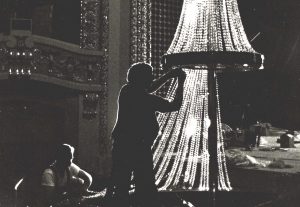Brewer Frederick Pabst ordered the construction of the Pabst Theater in 1895 after fire destroyed the Stadt Theater.[1] Located at 144 E. Wells St.,[2] the 1,339-seat venue hosts a variety of performing arts events.[3] A visual reminder of the Milwaukee’s German influence,[4] the Pabst Theater became a city landmark in 1967 and was listed on the National Register of Historic Places in 1972.[5]
The Pabst family owned the theater until 1953, when they sold it to the Pabst Theater Foundation.[6] The Common Council of Milwaukee bought it in 1961, although the Foundation continued to manage operations until 1969.[7] The Performing Arts Center’s opening[8] and the Pabst Theater Board’s refusal to negotiate with unionized stagehands[9] led to the theater’s closure in 1969. The city took direct control of its management.[10] Its historical designations, paired with preservation support from Mayor Henry Maier and Frederick Pabst’s descendant, August U. Pabst, saved the theater from demolition.[11]
Architect Otto Strack[12] incorporated a number of innovative safety measures such as fireproofing, air conditioning, and elevators[13] into the opulent four-story Victorian Baroque building’s design.[14] Its exterior features ornate ironwork, brick, and stone.[15] Deep red fabrics, heavy drapery, white and green marble, Greek statues,[16] and a 2-ton chandelier comprised of 33,000 hand-strung Austrian crystals[17] made the interior extravagant. Extensive 1928 renovations compromised its original glamour, but a major 1976 restoration project reversed many of these changes. Further renovations in 2000 made the theater more comfortable, modernized its amenities, and made it accessible to visitors with disabilities.[18]
Footnotes [+]
- ^ “From the Sentinel Files,” The Milwaukee Sentinel, November 10, 1970, accessed February 26, 2014, http://news.google.com/newspapers?nid=1368&dat=19701110&id=IZtRAAAAIBAJ&sjid=KhEEAAAAIBAJ&pg=1633,1722089; “Milwaukee’s Old Pabst Theater Regains Its Original Splendor,” Daily News, November 22, 1976, accessed February 26, 2014, http://news.google.com/newspapers?nid=1696&dat=19761122&id=fK0cAAAAIBAJ&sjid=2kYEAAAAIBAJ&pg=3329,4214752; City of Milwaukee, “Historic Designation Study Report: Pabst Theater” (Milwaukee, WI: Historic Preservation Commission, 1982), 2, accessed January, 27, 2014.
- ^ City of Milwaukee, “Historic Designation Study Report,” 1; Whitney Gould, “Hole Represents Progress for Pabst,” Milwaukee Journal Sentinel, June 17, 1997, accessed February 26, 2014, http://news.google.com/newspapers?nid=1683&dat=19970617&id=a3MaAAAAIBAJ&sjid=yy4EAAAAIBAJ&pg=6749,1523637.
- ^ “Milwaukee’s Old Pabst Theater Regains Its Original Splendor.”
- ^ City of Milwaukee, “Historic Designation Study Report,” 4.
- ^ James H. Charleton, “NRHP Registration Form: Pabst Theater,” Washington, DC: Department of Interior, National Park Service, WASO, History Division, August 20, 1991, 14, accessed February 26, 2014.
- ^ Joan W. Saltzstein, “When the Pabst Was Young and Gay,” The Milwaukee Journal, May 6, 1967, accessed February 26, 2014, http://news.google.com/newspapers?nid=1499&dat=19670506&id=glcaAAAAIBAJ&sjid=6ScEAAAAIBAJ&pg=5808,2498498; City of Milwaukee, “Historic Designation Study Report,” 2; “Milwaukee’s Old Pabst Theater Regains its Original Splendor.”
- ^ Charleton, “NRHP Registration Form: Pabst Theater,” 14.
- ^ Charleton, “NRHP Registration Form: Pabst Theater,” 14; “Milwaukee’s Old Pabst Theater Regains Its Original Splendor.”
- ^ Jan Joslyn, “‘New’ Pabst Gets Ovation from First Audience,” The Milwaukee Sentinel, September 24, 1976, accessed February 26, 2014, http://news.google.com/newspapers?nid=1368&dat=19760924&id=1nhQAAAAIBAJ&sjid=4hEEAAAAIBAJ&pg=3679,4003599
- ^ Charleton, “NRHP Registration Form: Pabst Theater,” 14.
- ^ “Milwaukee’s Old Pabst Theater Regains Its Original Splendor.”
- ^ Saltzstein, “When the Pabst Was Young and Gay.”
- ^ Charleton, “NRHP Registration Form: Pabst Theater,” 9; Pabst Theater, “History of the Pabst Theater.”
- ^ Charleton, “NRHP Registration Form: Pabst Theater,” 4; City of Milwaukee, “Historic Designation Study Report,” 4.
- ^ City of Milwaukee, “Historic Designation Study Report,” 2.
- ^ Charleton, “NRHP Registration Form: Pabst Theater,” 7; Pabst Theater, “History of the Pabst Theater,” Pabst Theater Foundation, 2014, accessed January 27, 2014.
- ^ Pabst Theater, “History of the Pabst Theater.”
- ^ Pabst Theater, “History of the Pabst Theater.”


0 Comments
Please keep your community civil. All comments must follow the Encyclopedia of Milwaukee Community rules and terms of use, and will be moderated prior to posting. Encyclopedia of Milwaukee reserves the right to use the comments we receive, in whole or in part, and to use the commenter's name and location, in any medium. See also the Copyright, Privacy, and Terms & Conditions.
Have a suggestion for a new topic? Please use the Site Contact Form.